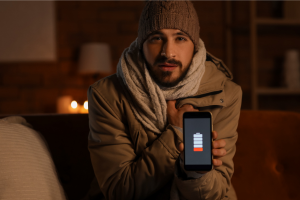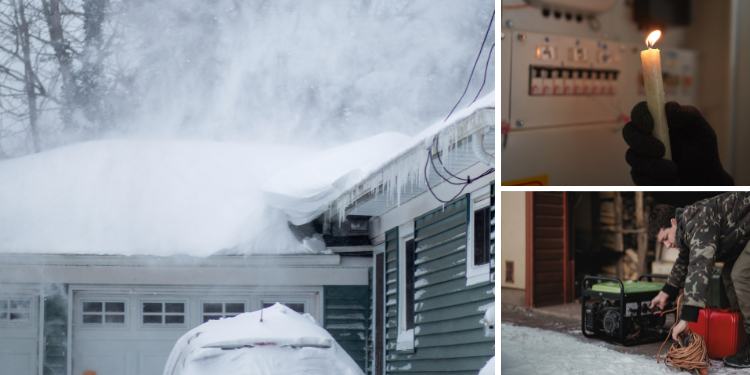Wintertime means snowstorms, at least for those who live in colder or more temperate climates. Even the Deep South can experience winter weather, but it probably won’t come with much snow. That snow, while beautiful, can be dangerous. It makes our roads difficult to drive on and can weigh down our power lines, causing them to break. The only question then, is just how long is the blackout going to last.
Long blackouts, defined as those which last more than three days, are on the increase. Some might try to blame that on climate change, but the reality is that it is mostly due to poor maintenance of our infrastructure. The same amount of snow and ice will cause lines to fail, which wouldn’t have failed even 20 years ago. At the same time, our grid is running near capacity at all times, reducing the ability to simply reroute power from somewhere else.
What this means is that we are all likely to experience a power outage sometime during the winter and that outage will take longer to repair. While most are repaired rather quickly, the increase in long blackouts means that we can’t count on them being repaired within an hour or two. The only thing we can count on is what we do ourselves, to make sure that our families will be okay.
Our Critical Electrical Needs
Pretty much everything we do today requires electricity. Even so, that doesn’t mean that everything we do is something that we need to do. There are a lot of things we can do without in a blackout, without it causing us any real harm. But there are also things which are critical to our survival, and which we need to maintain somehow, even when the power goes out. These things include
 • Heating our homes
• Heating our homes
• Lighting
• Refrigeration
• Emergency medical equipment (for those who need it)
• Pump for water (for those who are on a well)
• Some communications
Related: The First Thing You Should Do in a Winter Blackout
So, the real question we need to ask ourselves, is what are we going to do about these six things, so that we aren’t affected by a blackout; or if we are, that we are only minimally affected? While that might mean producing our own electrical power; it doesn’t necessarily mean that. We could come up with alternate plans.
Heating
The most critical thing to consider, when we’re talking about blackout proofing out homes, is heating. Those who experienced blackouts during Winter Storm Uri, in February of 2021, well remember how cold it got and how dangerous that cold was. Many thousands of people were displaced from their homes, because of not having any alternate means of heating. A few thousand even lost their lives to the cold.
 Within the prepping community, our most common alternate means of heating is wood. Wood fireplaces and wood-burning stoves have been around a long time and are extremely effective means of heating a limited area. But then, any system we use is only going to heat a limited area. We can’t really expect to heat our entire home during a blackout.
Within the prepping community, our most common alternate means of heating is wood. Wood fireplaces and wood-burning stoves have been around a long time and are extremely effective means of heating a limited area. But then, any system we use is only going to heat a limited area. We can’t really expect to heat our entire home during a blackout.
The problem with wood heat is that not everyone can use it. There are few landlords who will allow a fireplace or wood-burning stove to be installed into their apartments or rental homes. The fire risk is just too high. On the other hand, it’s the most cost-effective means of emergency heat for those who own their homes.
So, what do we do if we can’t use wood heat? Freeze?
The two other options to consider, when wood heat can’t be used is propane and kerosene. Both will heat a room, just like a wood-burning stove will; but will be more expensive to operate. Kerosene for heating is only available in some parts of the country. The key here is to have enough kerosene on-hand, as kerosene heaters will go through a five-gallon can in about 25 hours. That much kerosene will cost roughly $25.00.
Small propane heaters generally run off of one-pound propane bottles, which cost roughly $5 each. Compared to buying propane in 20-pound bottles, that’s about five times as expensive. While the actual run time varies from heater to heater, you can expect to be able to run the heater for about 3 hours at its maximum heat setting and about 6 hours at its minimum heat setting. That’s more expensive than kerosene, if you’re buying your propane in one-pound tanks. But it’s cheaper if you’re buying it in 20-pound tanks. An adapter exists, allowing you to fill the one-pounders from a 20-pound tank. And this is how you can make a propane tank to heat your home forever.
Watch out with both kerosene heaters and propane heaters, making sure that any you buy are rated for indoor use. Not all are and those which are not could lead to asphyxiation.
Lighting
Lighting is probably the easiest place to blackout proof our homes. First of all, we can simply go to bed when the sun goes down and wake up when it rises in the morning.

That greatly reduces our need for artificial lighting. If your home was built with ample windows or even a couple of skylights, you will probably have adequate lighting inside during the daytime hours.
But if not, you’re going to have to augment the natural light somehow.
While we can do that with flashlights and battery-operated lamps, it is considerably more cost-effective to use oil-burning lamps. Those will run an average of 258 hours on a gallon of oil, making them the lowest-cost alternative lighting available, even cheaper than candles. The lamps themselves don’t have to be expensive either, as there are several low-cost options available.
Refrigeration
Modern refrigerator/freezer units are actually very energy efficient.

That’s not much help if there’s no energy for them to use; but if you are producing your own electricity, that’s the first thing to consider plugging in. Even if it is not plugged in, most will keep food cold for a minimum of 24 hours, giving you time to get things organized and put your emergency plan into effect. The fridge would be your least of the problems with this.
In a way, worrying about refrigeration during a winter blackout is a bit of a joke, especially if the blackout was caused by a storm. As long as it is cold, you can take the food out of the fridge and put it in the garage or even on the back porch to keep it from spoiling. If there’s ice or snow outdoors, that can be harvested and put in the freezer to keep food cold. If you don’t want the mess of melting snow in your freezer, put the snow in an ice chest instead and move the food there.
Emergency Medical Equipment

This is one of those areas where you may not be able to come up with an alternative. Of course, that depends a lot on the type of equipment we’re talking about. Your wheelchair-bound family member may not be able to use their electric wheelchair for a few days; or that bedridden elderly relative who has a hospital bed in the home may not be able to adjust their bed.
What this means is that other family members will have to do what they can to help those people out. That’s really nothing new, as families have been in that place for centuries. We’ve just gotten used to having fancy medical equipment to use.
But not all emergency medical equipment falls into the category of not being absolutely necessary. If you have a family member who is on oxygen, their oxygen generator or pump might be necessary for their survival. That means either having enough oxygen in tanks to get them through or being able to generate enough electricity to operate that equipment.
Well Pump
Not everyone has a well on their property; but many of those who do depend on that pump as their only source of water. If the power goes out, their water goes out as well. at that time, they either have to be able to depend on stored water (something that we preppers do anyway) or producing enough electricity to run their well pump. Personally, if I had a well, I would make sure that I could produce enough electricity to run it as well.
Communications
Communications are probably the easiest problem to solve, as our modern communications don’t require a lot of electricity. Now, I’m not talking about running our televisions or getting on the internet here. I’m talking about calling emergency services or family members and that can be done with a cell phone.
 The real trick here is having a means of recharging your cell phone, even when the power is out.
The real trick here is having a means of recharging your cell phone, even when the power is out.
Unfortunately, most of the “solar phone chargers” that are advertised don’t produce enough power to fully charge your phone. It takes several days to fully charge a phone with them.
However, there are solar phone chargers which will fully charge a phone in a day. These are the larger, folding or flexible roll-up chargers, which provide a much greater surface area of solar cells. They are more expensive; but they will do the job, charging a phone in a day; keeping up with your phone’s electricity usage.
Producing Your Own Power
Regardless of how much you are able to do via alternate means, you really should have some means of electrical power production in your home. Some things just can’t be run without electricity and some of those are critical. The big problem is, most preppers don’t invest enough in being able to produce their own electricity. Two solar panels and one battery just isn’t enough.
Just running the essential items I mentioned above will probably require more than a dozen solar panels and a few batteries to store their power. But even that might not be enough, as a snowstorm can cover your solar panels, rendering them virtually useless. Fortunately, the panels are designed to absorb sunlight, so they tend to help make the melting process quick.
We preppers tend to shy away from gasoline generators, because we don’t see them as a viable long-term solution. But we need to re-evaluate that, in the light of short-term emergencies; those that are over in 30 days or less. Storing enough gasoline to run a generator continually for 30 days may be unrealistic; but storing enough to run a portable generator for a week isn’t; especially if that’s an inverter generator, as those burn less fuel. That’s why, if you have a generator on your property, do this immediately.
Whole-house generators are an expensive option, limited to those who have a lot of money. It’s not just the cost of the generator either; those require a lot of fuel and depending on the type of fuel used, it can cost a lot of money to run them. If you can afford it, that’s great; but if not, don’t ignore the possibility of a portable generator.
You may also like:
 9 Survival Uses for a Blacklight
9 Survival Uses for a Blacklight
How to Hide That You Still Have Power Left in a Blackout (Video)
The Worst Places to Be When an EMP Hits
Ingenious Ideas for Taking Care of Your Chickens
10 Foods You Should Store in Lard for a Long Shelf Life
Read the full article here
